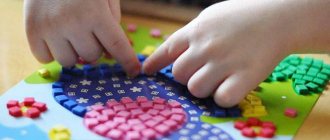The method of forming a language system (MFSL) for non-speaking children is used in working with various types of speech delay, such as: alalia, speech development disorder, stuttering, intellectual development disorders, Down syndrome, RDA. It was developed specifically for children with speech disorders of various natures, by Tamara Novikova-Ivantsova.
MFNP for non-speaking children reflects effective ways to solve the problem. These skills will be useful for both practicing speech therapists and beginning specialists. In addition, the material is presented in an accessible way for parents who want to conduct classes with their children on their own; this option will be an effective addition to the main therapy.
Early child development:
- Shichida method
It may seem that the complex is very simple, but in this case it is the consistency of the work that is important.
Principles of the technique
Tamara Novikova-Ivantsova is the author of methods for studying and correcting speech defects in children.
Tamara Nikiforovna is an Honored Teacher of Russia, a speech therapist with thirty years of experience in working with systemic speech pathologies in children.
Her method contains recommendations that are valuable not only for professional speech therapists, but also for beginners. In addition, the information in the manual is presented in accessible language, which will also be useful for mothers and fathers planning to study with their baby at home.
It is worth identifying general principles , which at first glance may seem too simple. But the whole essence of the technique lies in the systematic implementation of them .
For a child to be ready to speak, it is necessary:
- create an environment favorable for speech development;
- conduct training sessions on speaking practice on a regular basis.
Stages of speech therapy work
The Novikova-Ivantsova technique—“speech evocation”—is aimed at helping children with severe disabilities master phrasal speech. Speech therapy work includes several stages.
- Prelinguistic level - the emphasis is on the formation of a passive vocabulary, i.e., on understanding speech. It includes tasks such as working on the tempo-rhythmic component and practicing intonation. At this level, the babbling stage is practiced. Also at this stage, they learn to distinguish non-speech sounds and make a gradual transition to speech sounds.
- At the next stage, work is carried out on the formation and development of sound pronunciation, phonemic processes, and lexical-grammatical structure.
For speech therapy assistance to be effective, consistency must be observed and classes must be regular.
Factors influencing the quality of a child’s speech development
The child’s psyche, the level of his physical activity, and an environment conducive to communication are the three most important conditions for successful speech development.
It is worth considering that the development of speech skills is influenced by the state of the baby’s psyche . The ability to speak depends on how developed his thought processes, memorization, concentration, etc. Problems of varying levels of complexity can be solved by specialist doctors, from a speech therapist to a neuropsychologist.
The development of speech is also inextricably linked with the physical activity that the child experiences every day. Physical activity improves blood circulation and saturates the brain with oxygen. It is especially useful for children with speech delays to go to the pool and do gymnastics.
Immersion of the child in a speech environment plays a major role in the development of speech abilities . To create the necessary conditions around the baby
- communicate with him on various topics,
- use different words
- change your intonation
- speak clearly and clearly, pronounce your actions,
- Show your child illustrations or three-dimensional figures, commenting on them verbally.
One of the key tools for launching speech mechanisms according to the IFP is singing.
So combine business with pleasure. Listening to songs in your native language performed by your mother or close relatives has a beneficial effect.
This activates the speech mechanism, establishes a system of rhythm and tact, and phonemic perception of words. Therefore, one of the key elements of MFNS is music , which in one way or another affects the state of mind, can cause a change in mood and accompany it with speech.
Development of the syllabic structure of words in preschoolers with OHP levels I-II through a system of game exercises
Anastasia Glinina
Development of the syllabic structure of words in preschoolers with OHP levels I-II through a system of game exercises
Among the various speech disorders in preschool children with ODD levels I–II, one of the most difficult to correct is such a manifestation of speech pathology as a violation of the syllabic structure of words . This speech development is characterized by difficulties in pronouncing words of different syllabic composition . Correction of violations of the syllabic structure of words in children with general speech underdevelopment is a poorly studied and insufficiently described topic.
Every year the number of children suffering from severe speech disorders increases. Most of them have, to one degree or another, a violation of the syllabic structure of the word . If this violation is not corrected in time, in the future it will lead to negative changes in the development of the child’s personality , such as the formation of isolation and complexness, which will interfere with him not only in learning, but also in communicating with peers and adults.
Work on forming the syllabic structure of a word in a non-speaking child should begin from the preparatory stage - by practicing onomatopoeia.
Activation of speech imitation
Imitative speech reactions can be expressed in any sound complexes. The child’s speech practice is introduced to the smooth pronunciation of a series of vowels on one exhalation with a gradual increase in their number: ay, aui, aui, etc. Then the child is asked to pronounce a series of vowels, changing their place in the series : aui, aiu, uia, etc.
To achieve the desired effect in activating imitative speech activity, it is necessary to start with the development of imitation in general : “Do as I do”
. It is necessary to teach children to imitate actions with objects, movements of arms and legs.
As a result of work at this stage of the formation of the syllabic structure of a word, children must learn to correlate objects and actions with their verbal designation .
At this stage of work, you can use manuals that are designed for working with a non-speaking child:
1. Dedyukhina G.V. Kirillova E.V. Learning to speak. 55 ways to communicate with a non-speaking child.
2. Sozonova N. Read before speaking.
Next, when amorphous words , you can move on to the phrase:
1. Novikova-Ivantsova T. N. “From word to phrase ” book 1, 2, 3.
The following aids can be used with children with intellectual disabilities:
1. Shishkina N. A. “My first words .”
2. Kislyakova Yu. N. Education and training of children with severe speech impairments.
Next, we proceed to the main correction stage.
Formation of the first forms of words
First of all, it is necessary to get children to reproduce a stressed syllable (THE HOUSE IS HERE, and then the intonation-rhythmic pattern of one-, two-, three-syllable words ( the child can reproduce of the word (ANYA MAMA BEADS VASE BANANA MACHINE)
.
By the end of this period, children should know the place of stress in memorized words , reproduce the rhythmic-intonation structure of two- and preferably three-syllable words . At this stage, the following games can be used:
1. Development of auditory attention , auditory memory, auditory perception:
where did you call?
recognize a musical instrument by its sound .
how many times did you hit the drum?
2.Various ways to play rhythm:
- clapping hands,
- tapping the ball on the floor,
- use of musical instruments - drum , tambourine, metallophone.
• Clap your hands as many times as there are dots on the die;
• Count how many times you clap your hands and find the side of the cube with the required number of dots (the rhythm is first suggested as simple and then complex)
;
• Reproduction of a certain rhythm according to an adult , according to a given pattern (remember the forgotten game of palms )
Features of the formation of the syllabic structure of words with a consonant cluster
We start with monosyllabic words (bridge bush.)
.
When moving to words with a combination of 2 and 3 compounds, it should be taken into account that the division of words into syllables should occur at the junction of morphemes, for example: cat (not cat)
.
Features of the formation of the syllabic structure of a word based on the material of phrasal speech
Gradually, these words can be introduced into a phrase.
When memorizing poems, it is necessary to make sure that children understand their content, for which appropriate questions are asked about the pictures.
Children with speech underdevelopment have difficulty mastering the syllabic structure of words ; they need special remedial pedagogical training. Preschool children need to be presented with all the material in a playful , interesting form; for this purpose, special games have been developed for the formation of the syllabic structure of words .
To make it easier for a child to learn the structure of a word, the teacher needs to involve as much motor activity as possible, since with movement the child will better consolidate speech material. Words of different syllabic structures can be clapping , tapping, jumping, stepping away, and so on.
GAMES
TO DEVELOP THE SOUND-SYLLABILITY STRUCTURE OF THE WORD :
1. «Syllable lacing»
:
development of fine motor skills , development of the syllabic structure of three-syllable words .
2. "Piano"
: finger movements correspond to one
syllable .
3. "Steps"
: It is necessary, pronouncing
the word syllable by syllable , to climb the steps of a toy ladder with your fingers. The words can be suggested orally or depicted in a picture.
4. “Find your house”
: matching pictures by the number of
syllables in words .
5. “ Syllable Lotto ”
: automation of sounds in
words , learning to divide words into syllables .
6. “Walkers”
: there are
“crumbs”
.
Children are divided into two teams. When pronouncing words, a step is taken for each syllable . If the word is divided into syllables incorrectly , the child returns to the starting position.
7. Development of the syllabic structure of words in classes on the sound culture of speech.
8.Use of computer technology in the classroom:
• "Conductor"
: we divide
syllables into syllables , as if conducting.
• “What do you remember?”
The speech therapist lays out 3-4 pictures in front of the child and says:
“Look at the objects, remember them, and then name what you remember
.
In conclusion, I would like to add that the work of a speech therapist cannot and should not be standardized. Activation of various analyzers during classes using this lexical material (when the child must observe, listen to the name of an object or action, depict a designation or purpose with a gesture, name it himself) contributes to a more solid consolidation of the material. We recommend using a predominantly playful form of classes , only in this way can arouse the need for communication and interest in the exercises , which, in turn , will provide an emotional impact and contribute to the development of speech imitation .
Stages of speech development according to MFSL
Screaming, babbling, and babbling are the most important stages in the development of a child’s speech.
Scream
This is a reflexive reaction of a person to the influence of external stimuli . A child screams when he is uncomfortable, when he experiences pain, hunger, thirst, or any unpleasant sensations. A scream is characterized by ringing and loudness, a short inhalation and a long exhalation, during which the sound is produced.
Children who have some abnormalities in the nervous system make either a deafening sound or replace it with quiet exclamations with intermittent sobs. However, there may not be a scream. Most often, the period of active “screaming” ends after 2 months from the date of birth of the child .
Booming
This is a long and singsong extraction of vowel sounds . Moreover, it can often be accompanied by the reproduction of consonants. Here the child already picks up the parents’ intonation, tries to accompany it with his own sounds, he wants to control his speech apparatus in order to convey the idea. But the device is not yet ready for this, since it is in a transitional state.
The parent’s task is to actively maintain an emotional connection with the child, communicate with him using intonation, its tonality, rhythm, but do not forget about words.
Babbling
At the age of five to nine months, the child’s speech development moves to a new stage of babbling . This is the repeated repetition of the same word or sound combination, syllable, which can form elementary words. For example, “ma”, “pa”, “dya”, and others. While the child learns to perceive certain expressions by ear, the depth of exhalation is formed, which the baby learns to control. At 10 months, some children can already form words from the same syllables - “mother”, “uncle”, “daddy”, etc.
At one year of age, children have about 10 words or more in their luggage . It is noteworthy that girls learn new words faster.
By the age of one and a half years, children are already able to pronounce some short phrases.
It is possible that at any stage the child will experience a disturbance or delay . This leads to deformation of the speech system and difficulties, causing concern among loved ones. To restore the sequence in the stages, it is recommended to follow the Novikova-Ivantsova method and go through all the necessary levels of screaming, humming and babbling in turn. Then it will be possible to pronounce sounds, syllables, words and entire phrases.
Basic principles of the INF
This technique is based on the ontogenetic principle of speech development, which consists of several important stages:
Scream
The appearance of a cry is associated with human reflexes and it appears as a result of the action of certain external stimuli. Basically, these are conditions that cause discomfort in the child, such as pain, thirst or hunger, etc. In accordance with the norm, the cry should be loud and sonorous; it is also distinguished by a short inhalation and a long exhalation. In children with a disorder of the nervous system, the cry is either too deafening or too quiet and more like sobs. It may also not exist at all. Typically, the crying period lasts up to two months from birth.
Booming
Gulenie is a sing-song pronunciation of drawn-out vowel sounds, which is often combined with consonants. Intonation expressiveness is the main factor that parents should pay attention to during this period. This is due to the fact that the child’s speech apparatus is preparing to begin to pronounce sounds, remembers intonation, and tries to control it. The child must catch the parent’s speech and respond to it with laughter or a set of sounds. At this stage, his emotional connection with the parent is important.
The significance of the technique
Novikova-Ivantsova’s development not only helps children speak, it serves as a necessary tool in the hands of speech therapists who study disorders in the field of word structure, tempo, timbre, rhythm, and sound production in general.
Her manual includes a collection of techniques that are aimed at correcting speech-auditory perception - in particular - and eliminating problems of the speech apparatus - in general.
According to the International Nuclear Law Framework there are several stages:
- preliminary , where classes are conducted on the sense of rhythm;
- direct practice , during which exercises are performed to develop memory, motor skills, pronunciation of vowels, study of syllables, words, songs with accompanying visual material.
More detailed and comprehensive information about working with non-speaking children can be found in the video material of the author of the methodology in two parts.
Part 1
Part 2
Using touch spheres
At the very beginning of work using the method of Novikova-Ivantsova T.N. During classes, various sensory areas are used:
- visual - the child is shown pictures-symbols of sounds;
- tactile - you need to not just talk about how the articulatory apparatus works, the child must feel the work of the lips, tongue and vocal cords;
- auditory perception - melodies-rhythms are used in work.
Particular emphasis in the work is placed on the tempo-rhythmic component and auditory perception. Therefore, the Novikova-Ivantsova method contains many tasks using music. This helps to form not only the articulatory apparatus, but also correct speech breathing.
Features of the technique
There are various techniques that are aimed at helping non-speaking children. What makes Novikova-Ivantsova’s work stand out?
- From the first lessons, tasks are included to work on the tempo-rhythmic side of speech and intonation.
- The work uses 6 melodies that correspond to the 6 syllabic rhythms of the Russian language.
- Also, at the initial stages, they work on developing correct speech breathing and teaching the child to sing.
- Consonant sounds are not produced in isolation, but in combination with vowels, i.e., in the form of syllables.
- In the first lessons, the emphasis is on tactile sensations from the pronunciation of sounds.
It is these features that distinguish the Novikova-Ivantsova technique.
results
Quite often, speech therapists use the Novikova-Ivantsova technique to work with non-speaking children. And many admire the results achieved, noting the progress of children with alalia. But some of the disadvantages note that you need to do only “singing” for several months, so not all children and parents like such activities. Others include tasks they like in their classes. But the main thing is to maintain consistency and take into account all the features of this technique.
Classes based on Novikova-Ivantsova’s manual are an opportunity for children with severe speech impairments to learn to communicate with people. This technique takes into account the ontogenesis of speech, which allows for the most effective construction of speech therapy work.






